Posts Tagged ‘baby Jesus’
-
THE MAGIC IS IN THE DETAIL
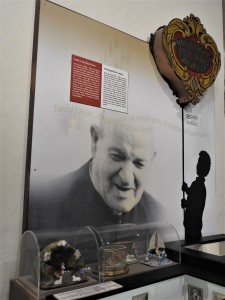 Although the main characters of the nativity scene are Joseph, Mary and baby Jesus, different cultures have added and altered the original representation in order to include their own characteristics. Some of these varying interpretations can be viewed in a permanent exhibition at the Inquisitor’s Palace in Birgu, which also houses the National Museum of Ethnography.
Although the main characters of the nativity scene are Joseph, Mary and baby Jesus, different cultures have added and altered the original representation in order to include their own characteristics. Some of these varying interpretations can be viewed in a permanent exhibition at the Inquisitor’s Palace in Birgu, which also houses the National Museum of Ethnography.In Malta, it was St George Preca (1880 – 1962) who fostered a lasting Christmas cult through his Society of Christian Doctrine. On Christmas Eve of 1921, he organized the first procession with a statue of baby Jesus. He also started the tradition of giving a crib and a statue of baby Jesus to every child who attended the MUSEUM centres.
In the exhibition, an image of Preca looks over at a rudimentary crib which has initiated a tradition that is still celebrated nowadays. A detailed diorama portrays further this tradition, showing a MUSEUM Superior handing out a crib to a boy, while a number of other children are already joyfully holding their cribs. An altar which is included in the diorama is decorated with flowing white vetch.
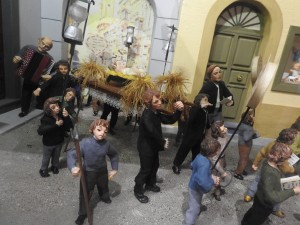 Another diorama looks like a time capsule showing the traditional procession of baby Jesus together with other local customs. Not only can one observe the MUSEUM members carrying the statue of baby Jesus, but one can also delight at the children carrying lights and Christmas messages while singing Christmas carols. The context is further enriched by the presence of traditional Maltese town houses, with their colourful wooden doors and with their wide open windows decorated with a small statue of baby Jesus.
Another diorama looks like a time capsule showing the traditional procession of baby Jesus together with other local customs. Not only can one observe the MUSEUM members carrying the statue of baby Jesus, but one can also delight at the children carrying lights and Christmas messages while singing Christmas carols. The context is further enriched by the presence of traditional Maltese town houses, with their colourful wooden doors and with their wide open windows decorated with a small statue of baby Jesus.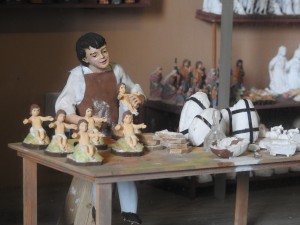 These two dioramas form part of a set that was donated to Heritage Malta by Austin Galea; a well-established artisan and personality among local crib enthusiasts, and a founding member of the Għaqda Ħbieb tal-Presepju (Malta). The set of dioramas give life to further Christmas traditions, such as the sermon of the altar boy during Christmas’ eve mass, a large crib displayed for public viewing, a group of craftsmen in a workshop manufacturing statues and cribs, and a Christmas lunch being enjoyed by a family.
These two dioramas form part of a set that was donated to Heritage Malta by Austin Galea; a well-established artisan and personality among local crib enthusiasts, and a founding member of the Għaqda Ħbieb tal-Presepju (Malta). The set of dioramas give life to further Christmas traditions, such as the sermon of the altar boy during Christmas’ eve mass, a large crib displayed for public viewing, a group of craftsmen in a workshop manufacturing statues and cribs, and a Christmas lunch being enjoyed by a family.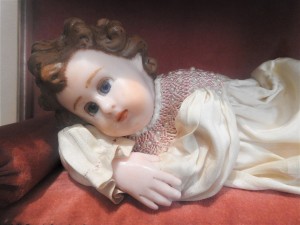 Galea has also donated two large nativity scenes which are typically exhibited in windows of private houses during the Christmas season in Malta. Other donations by him include different traditional statues of baby Jesus. Traditionally, the baby Jesus statues were made of wax to obtain a soft and translucent finish. The statues were eventually dressed up in an embroidered tunic, while many borrowed real hair from a toddler’s crowning curls.
Galea has also donated two large nativity scenes which are typically exhibited in windows of private houses during the Christmas season in Malta. Other donations by him include different traditional statues of baby Jesus. Traditionally, the baby Jesus statues were made of wax to obtain a soft and translucent finish. The statues were eventually dressed up in an embroidered tunic, while many borrowed real hair from a toddler’s crowning curls.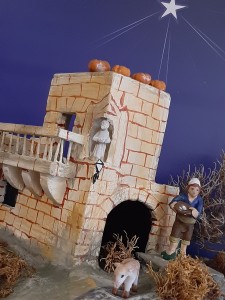 A large Maltese crib is also part of Galea’s generous donation. The crib is a comprehensive study of Maltese traditions in itself. Typical Maltese figurines are dressed in traditional local costumes, and among them, one also finds the unique Maltese symbolic characters. The Stupefied figurine represents those who are impressed by the profound meaning of the unique happening. The Beggar represents the poor who find consolation in Christ. The Climber represents those who find it difficult to understand the significance of Christ’s incarnation but strive to discover out. The Folk Singers represent communal association in praising the Lord, while the Sleeper represents those who ignore the immeasurable benevolence of Christ. The rugged landscape with its terraced fields, sparse vegetation, low-profile unpretentious farmhouses and a windmill are reminiscent of the rural ambience of the old times.
A large Maltese crib is also part of Galea’s generous donation. The crib is a comprehensive study of Maltese traditions in itself. Typical Maltese figurines are dressed in traditional local costumes, and among them, one also finds the unique Maltese symbolic characters. The Stupefied figurine represents those who are impressed by the profound meaning of the unique happening. The Beggar represents the poor who find consolation in Christ. The Climber represents those who find it difficult to understand the significance of Christ’s incarnation but strive to discover out. The Folk Singers represent communal association in praising the Lord, while the Sleeper represents those who ignore the immeasurable benevolence of Christ. The rugged landscape with its terraced fields, sparse vegetation, low-profile unpretentious farmhouses and a windmill are reminiscent of the rural ambience of the old times.Besides donating his first clay crib figurines which were given to him by his aunties and an unusual crib made of sacks that was constructed by him, Galea shares also his knowledge relating to Christmas crib construction in a short video which forms part of this exhibition.
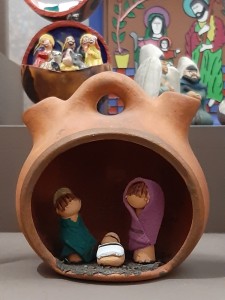 Another intriguing element in this exhibition is the donation of numerous miniature cribs which were brought by Albert and Lina McCarthy from all over the world. The professional tour managers have been gathering this impressive collection since the early 90s. Their collection amounts to more than 500 miniature works of art, a representative selection of which is on display at the Inquisitor’s Palace.
Another intriguing element in this exhibition is the donation of numerous miniature cribs which were brought by Albert and Lina McCarthy from all over the world. The professional tour managers have been gathering this impressive collection since the early 90s. Their collection amounts to more than 500 miniature works of art, a representative selection of which is on display at the Inquisitor’s Palace.Exhibited in four different sections, the varying nativity scenes representing North and East Europe, Southern Europe and the Near East, North and South America, and Africa, Asia, the Far East and Australia are simply enchanting. The magic is in the detail of each crib which presents the nativity scene in various contexts, with distinct characters and in diverse materials.
 Some of the most notable are the terracotta nativity sets from Hungary and Peru, the ceramic sets from Denmark and the Philippines, the engraved wooden shoe from Amsterdam, the wooden sets of Germany, Austria, Japan and Iran, the metallic artwork from Bali, the sack nativity set from Sri Lanka and the clay figurines of North Africa set in a bedouin tent, dressed in traditional costumes and accompanied by a camel instead of farm animals.
Some of the most notable are the terracotta nativity sets from Hungary and Peru, the ceramic sets from Denmark and the Philippines, the engraved wooden shoe from Amsterdam, the wooden sets of Germany, Austria, Japan and Iran, the metallic artwork from Bali, the sack nativity set from Sri Lanka and the clay figurines of North Africa set in a bedouin tent, dressed in traditional costumes and accompanied by a camel instead of farm animals.A visit to this permanent exhibition held at the Inquisitor’s Palace is most educational and entertaining for children, and also curious and insightful for adults. The exhibits are a tribute to local and foreign artisans who have used their creativity to reproduce the significant nativity scenes in various intriguing representations.
(Published in Christmas Times magazine issue with The Times of Malta dated 7th December 2019)
-
Christmas inspiration
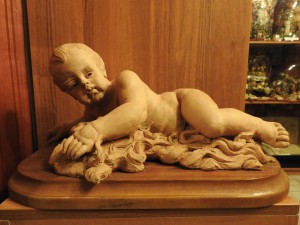 Thousands of baby Jesus statues begged for my attention during a visit at Il-Mużew tal-Bambini in Birkirkara. However, I felt mostly intrigued by a particular terracotta figure which looked completely different from the rest. Its face had captivatingly unique features and the rest of the body was very life like. Yet it was only when I met its creator, sculptor Chris Ebejer, that I understood its real value, since that baby Jesus was not just a statue but a singular work of art.
Thousands of baby Jesus statues begged for my attention during a visit at Il-Mużew tal-Bambini in Birkirkara. However, I felt mostly intrigued by a particular terracotta figure which looked completely different from the rest. Its face had captivatingly unique features and the rest of the body was very life like. Yet it was only when I met its creator, sculptor Chris Ebejer, that I understood its real value, since that baby Jesus was not just a statue but a singular work of art.“My baby Jesus creations are not popular statues that are meant for domestic use or simply to act as a representation of the son of God. They have an added value because they are sculptures and not just statues,” explained Chris when I met him at his studio in Mqabba.
“When I do such works, my aim is not only to reproduce the tenderness of a baby but also to relay an artistic style and a distinct message. Such art pieces are not restricted just to the Christmas season but they can be cherished all throughout the year due to their artistic significance.”
An unfinished terracotta sculpture of a toddler Jesus lay waiting on a workbench. I couldn’t help noticing some subtle facial similarities between this work and the other one that I had viewed before. I was curious to know whether a sculptor would have a specific image in mind of how Jesus should be represented.
“Before starting to work on something, an artist needs to have a vision of what he intends to create. One wouldn’t picture the exact image in mind but there would already be an idea of the shape, the composition, and the layout of the figure. Details will not be clear but each artist will subconsciously compose some particular features which are typical of his style.”
“I must say that the facial features of this figure were inspired by those of my nephew. When he was a baby and later on a toddler, I studied closely his facial characteristics in order to explore the difference that exists between such a young face and that of an adult. For example, I observed that a toddler’s forehead is large when compared to the rest of the face, the upper lip is usually protruding, the cheeks are chubby and the neck is fleshy.”
The sculpted figure of Jesus looked quite human and earthly and I wondered whether such work involved a spiritual process as well?
“Whenever I am creating a sculpture, my foremost thought is always art. I am not motivated by any religious intentions and I do not aspire to encourage faith or to have people praying in front of my work. I have to admit that the subject is irrelevant to me.”
Nonetheless, although creativity and originality are always his primary goals, Chris revealed that there is a limit on how much one can move out of the religious figures’ codified facial characteristics which our culture has learnt to decipher and expect.
“No one has any idea how Jesus actually looked like, neither as a baby or a child, nor as an adult. Indeed, both his face and the way in which he is represented have changed considerably along the centuries. The belief that some images such as the Veil of the Veronica and the Shroud of Turin could be historically authentic has influenced very much the present impression of Jesus’s face. Once such images are portrayed over and over again and are accepted by society, their characteristics become codified and this will help people to recognize immediately the figure of Jesus. Certainly, as an artist, there are ways and means of how to be creative when dealing with such a significant figure. However, one must know his limits so as not to come out with a profane work.”
In earlier times, when art could reach out to people more than books, especially due to widespread illiteracy, the Catholic Church often used symbols within artistic works to deliver its messages.
“There were various symbols that were portrayed with baby Jesus. In Botticelli’s artwork Madonna of the Pomegranate, Jesus is holding a pomegranate in representation of his suffering and resurrection. On the other hand, in the Madonna of the Carnation by Leonardo da Vinci, Jesus is reaching out to a carnation which is the symbol of Passion.”
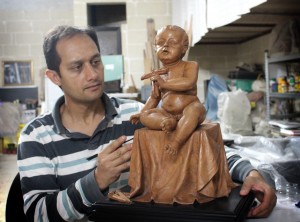 Chris pointed out to his sculpture of toddler Jesus where he had also included such symbols.
Chris pointed out to his sculpture of toddler Jesus where he had also included such symbols.“Although in this sculpture, Jesus might look just like any child, there are a number of clues which will hint to the viewer that there is more to it than that. In fact, the child in sitting on a humble box draped in cloth in allusion to when the babies of ancient royal families were placed on thrones. The young figure is holding a miniature cross in his hand and three nails lie down beneath him on the ground. All these objects, together with the boy’s meditative expression as he looks far out beyond his tender age, create an effect which suggests that the child is already seeing his mission for the future.”
As he continues with some final touches on this latest sculpture, Chris reveals that the autumn and wintery seasons tend to inspire him to create new works.
“I am deeply influenced by the change of seasons and by the transformation which they breed in the coloured landscape. Being from the rural village of Qrendi, I am very attracted to nature and my senses are intensely attuned to it. As the leaves start turning orangey red, melting in with the aroma of wet brown soil and the liquorish scent of carobs, I feel stimulated to think about Christmas and the birth and life of Jesus, and it is mainly during this period when I come up with new ideas for works with religious themes. Moreover, the earlier approach of night during these days entices me to stay more indoors and this provides me with much more time to work.”
A look at some of his finished works that were in his studio indicated that this sculptor had a particular preference to terracotta.
“I do love working with terracotta as besides being a natural medium, it also has a pleasant warm colour. It is also more fluid and softer to handle than other materials and so it allows me to work in greater tranquillity. The fact that terracotta has been in use since ancient times enhances also in me that sublime feeling that by utilising this medium, I am helping to keep this traditional technique alive.”
Apart from baby Jesus sculptures, during this season, Chris tends also to come out with new nativity creations.
“Tenderness and the love for the family are the main messages imbued in these works.”
(This article was published in Christmas Times magazine issued with The Times of Malta dated 8th December 2016)
-
A Christmas Nursery
Even as a young child, Paul Pace was very fond of baby Jesus statues. Probably because they reminded him of a number of significant familial moments. His grandma gave him a small wax statue of baby Jesus in order to ease down his sorrow after his father George had to leave for a long time to work with the Navy. On another occasion, his father surprised him when he bought him an expensive statue of baby Jesus that he had longed for, after he succeeded to win a lottery. Now, at 69, Paul owns a collection of more than 2000 of such statues which he has lovingly gathered in a museum that he called ‘Il-Mużew tal-Bambini’.
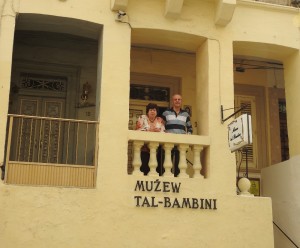 His wife Mary shares his passion and she is always present to give him a hand in this museum which they have purchased together.
His wife Mary shares his passion and she is always present to give him a hand in this museum which they have purchased together.“It is such a pleasure to see people getting emotional when they visit our museum. Some become very nostalgic as they remember their childhood. Others notice some statue which was similar to the one that their parents had, and they start recalling their memories. A number of visitors get inspired to buy a baby Jesus statue of their own, while some others decide to go home and search for their neglected antique statue which their grandma had left them,” Paul said.
Since its inauguration in 2010, il-Mużew tal-Bambini has become quite renowned both with the local and the foreign public. Although it is available for viewing by appointment throughout the year, most of the visitors attend to this museum during the Christmas season.
“There is always something new to see because we are continually adding to our collection. Even though by now, we have a problem with space, when we find a particular baby Jesus statue which we love, we just can’t help not to own it,” admitted Mary.
Certainly, the museum is a wonder to behold. The provenance of the statues is worldwide, thereby providing a rich overview of the different cultures. Skin colour, facial characteristics, and posture of these statues vary accordingly.
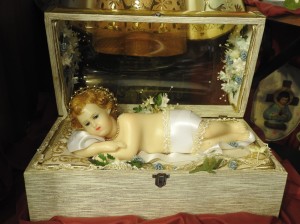 A delicate looking baby Jesus which was made in Malta, rests in a musical box and moves his eyes and hands. A dark skinned baby Jesus made from wood in Tanzania looks exotic amongst the others. A curly black-haired toddler Jesus, wearing the traditional costume of Perù, sits on a chair and weeps after stepping on a thorn, according to a local legend. A wooden statue from Betlehem shows Jesus as a boy dressed as a king and sitting on an elegant throne. A teenage Jesus from Atocia is also resting on a chair, but this time, he wears the clothes of a pilgrim and carries a rod. An intricately adorned statue of Jesus from Trapani is embellished with pomegranate for good luck.
A delicate looking baby Jesus which was made in Malta, rests in a musical box and moves his eyes and hands. A dark skinned baby Jesus made from wood in Tanzania looks exotic amongst the others. A curly black-haired toddler Jesus, wearing the traditional costume of Perù, sits on a chair and weeps after stepping on a thorn, according to a local legend. A wooden statue from Betlehem shows Jesus as a boy dressed as a king and sitting on an elegant throne. A teenage Jesus from Atocia is also resting on a chair, but this time, he wears the clothes of a pilgrim and carries a rod. An intricately adorned statue of Jesus from Trapani is embellished with pomegranate for good luck.“Our interest in this aspect has led us to travel to countries which are related to the life of Jesus, and from which we knew that we could find such statues. Our visit to the Holy Land was an incredible experience which gave us the opportunity to walk in the same roads where Jesus lived. Moreover, it was an ideal country from where to acquire some beautiful statues for our collection,” remarked Paul.
“When we visited Prague, we bought 42 different baby Jesus statues!” exclaimed Mary.
 They just had to, they explained, as they saw my startled reaction. This was because according to an old tradition, the statue of baby Jesus in Prague is dressed in different coloured clothes each day. Therefore, they were bound to purchase a number of statues which showed Jesus in several dresses. Nevertheless, not all the statues bought ended up in the museum, since some of these were presents for family members and friends.
They just had to, they explained, as they saw my startled reaction. This was because according to an old tradition, the statue of baby Jesus in Prague is dressed in different coloured clothes each day. Therefore, they were bound to purchase a number of statues which showed Jesus in several dresses. Nevertheless, not all the statues bought ended up in the museum, since some of these were presents for family members and friends.“Many of those who visit our museum are curious to know whether we can remember all our statues, which of course, we do. We can also recall all the places from where we have obtained these items. Each statue has an interesting story behind it and we love to share them with whoever’s interested to listen,” Paul said.
I was all ears and I felt simply fascinated when their narrative started to pour in. One of these stories entailed how they managed to buy a statue of baby Jesus which belonged to St. Ġorġ Preca. Another was related to an excellent bargain which Mary made unknowingly, when she bought a statue for her husband for a low price, and then found out that it dated to the 18th century. I loved also the account relating to a particular container made of mica which was produced in Malta by a German prisoner of war during World War II, and was utilized to hold a statue of baby Jesus.
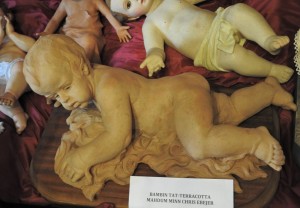 “We have many antique statues but the oldest one that we know the date of goes back to 1730. The smallest statue is about 15mm long, whereas the largest one has a length of 80cms. The materials of these statues varies widely and include: stone, alabaster, marble, woods of different kinds, wax, ceramic, concrete, lava, straw, plastic, wool, and even bull’s horn,” Mary explained.
“We have many antique statues but the oldest one that we know the date of goes back to 1730. The smallest statue is about 15mm long, whereas the largest one has a length of 80cms. The materials of these statues varies widely and include: stone, alabaster, marble, woods of different kinds, wax, ceramic, concrete, lava, straw, plastic, wool, and even bull’s horn,” Mary explained.Yet the strangest was yet to come…
“One day, we had a statue which lost its synthetic hair and we decided to try to replace it with some hair of one of our daughters. The experiment succeeded and soon, we provided the hair to a number of other statues by trimming some hair from our other daughter and eventually also from that of our nephews,” smiled Paul as he pointed them out proudly.
Each time that I observed the statues, I noticed a different one which I had not seen before. The collection looked literally endless, and yet each statue was unique. Whilst some of the statues showed simple features, mostly due to the artistic fashion of the time, others were quite elaborate and pretty. Yet there were also a number of outstanding characters which stood out from the rest.
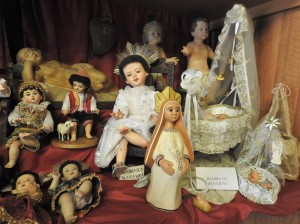 “The main aim of this museum is to share the sweetness of Christmas and the joy which is inherent in each statue of baby Jesus,” revealed the couple.
“The main aim of this museum is to share the sweetness of Christmas and the joy which is inherent in each statue of baby Jesus,” revealed the couple.However, this place offers much more than that since it nurtures love for one’s family, whilst it cherishes an appreciation for diversity. Undoubtedly, this collection is also an invaluable source for those who are interested to study the changes which took place along the years in the production of such precious artworks.
Il-Mużew tal-Bambini which is located at 17, Triq Santa Tereża, Birkirkara, will be open for the public from Sunday, 13th December 2015 to Wednesday, 6th January 2016.
Opening times: Monday to Saturday from 4:30pm – 8:00pm, Sundays and Public Holidays from 9:00am – noon and from 4:30pm – 8:00pm. For more information, one can call 21492111.
(This article was published in CHRISTMAS TIMES Suppliment issued with The Times of Malta dated 8th December 2015)
Travelogue
Archives
| M | T | W | T | F | S | S |
|---|---|---|---|---|---|---|
| « Jan | ||||||
| 1 | 2 | 3 | 4 | 5 | 6 | 7 |
| 8 | 9 | 10 | 11 | 12 | 13 | 14 |
| 15 | 16 | 17 | 18 | 19 | 20 | 21 |
| 22 | 23 | 24 | 25 | 26 | 27 | 28 |
| 29 | 30 | |||||
Recent Posts
- A MATTER OF FATE
- MALTA’S PREHISTORIC TREASURES
- THE MAGIC IS IN THE DETAIL
- THE SELLING GAME
- NEVER FORGOTTEN
- Ġrajjiet mhux mitmuma – 35 sena mit-Traġedja tal-Patrol Boat C23
- AN UNEXPECTED VISIT
- THE SISTERS OF THE CRIB
Comments
- Pauline Harkins on Novella – Li kieku stajt!
- admin on IL-KARNIVAL TRAĠIKU TAL-1823
- Albert on IL-KARNIVAL TRAĠIKU TAL-1823
- Martin Ratcliffe on Love in the time of war
- admin on 24 SENA ILU: IT-TRAĠEDJA TAL-PATROL BOAT C23